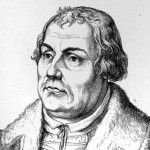Keith Matthison, author of The Shape of Sola Scriptura (Canon Press, 2001), once wrote a helpful overview piece on Scripture and tradition for Modern Reformation. For more information about Modern Reformation, visit www.modernreformation.org or call (800) 890-7556. All rights reserved.
Justin Taylor re-produced a section of it below, adding his own headings.
The Reformation debate over sola Scriptura did not occur in a vacuum. It was the continuation of a long-standing medieval debate over the relationship between Scripture and tradition and over the meaning of “tradition” itself.
TRADITION 1 (ONE-SOURCE)
In the first three to four centuries of the church, the church fathers had taught a fairly consistent view of authority. The sole source of divine revelation and the authoritative doctrinal norm was understood to be the Old Testament together with the Apostolic doctrine, which itself had been put into writing in the New Testament. The Scripture was to be interpreted in and by the church within the context of the regula fidei (“rule of faith”), yet neither the church nor the regula fidei were considered second supplementary sources of revelation. The church was the interpreter of the divine revelation in Scripture, and the regula fidei was the hermeneutical context, but only Scripture was the Word of God. Heiko Oberman (1930-2001) has termed this one-source concept of revelation “Tradition 1.”
TRADITION 2 (TWO SOURCES)
The first hints of a two-source concept of tradition, a concept in which tradition is understood to be a second source of revelation that supplements biblical revelation, appeared in the fourth century in the writings of Basil and Augustine. Oberman terms this two-source concept of tradition “Tradition 2? (Professor Oberman had many gifts. The ability to coin catchy labels was apparently not one of them). It is not absolutely certain that either Basil or Augustine actually taught the two-source view, but the fact that it is hinted at in their writings ensured that it would eventually find a foothold in the Middle Ages. This would take time, however, for throughout most of the Middle Ages, the dominant view was Tradition 1, the position of the early church. The beginnings of a strong movement toward Tradition 2 did not begin in earnest until the twelfth century. A turning point was reached in the fourteenth century in the writings of William of Ockham. He was one of the first, if not the first, medieval theologian to embrace explicitly the two-source view of revelation. From the fourteenth century onward, then, we witness the parallel development of two opposing views: Tradition 1 and Tradition 2. It is within the context of this ongoing medieval debate that the Reformation occurred.
MAGISTERIAL REFORMERS: LET’S RETURN TO TRADITION 1 NOT THE INNOVATION OF TRADITION 2
When the medieval context is kept in view, the Reformation debate over sola Scriptura becomes much clearer. The reformers did not invent a new doctrine out of whole cloth. They were continuing a debate that had been going on for centuries. They were reasserting Tradition 1 within their particular historical context to combat the results of Tradition 2 within the Roman Catholic Church. The magisterial reformers argued that Scripture was the sole source of revelation, that it is to be interpreted in and by the church, and that it is to be interpreted within the context of the regula fidei. They insisted on returning to the ancient doctrine, and as Tradition 1 became more and more identified with their Protestant cause, Rome reacted by moving toward Tradition 2 and eventually adopting it officially at the Council of Trent.
(Rome has since developed a view that Oberman has termed “Tradition 3,” in which the “Magisterium of the moment” is understood to be the one true source of revelation, but that issue is beyond the scope of this brief essay.)
RADICAL REFORMERS AND 18TH CENTURY AMERICANS: LET’S ABANDON TRADITION 1 AND TRADITION 2 AND GO WITH TRADITION 0
At the same time the magisterial reformers were advocating a return to Tradition 1 (sola Scriptura), several radical reformers were calling for the rejection of both Tradition 1 and Tradition 2 and the adoption of a completely new understanding of Scripture and tradition. They argued that Scripture was not merely the only infallible authority but that it was the only authority altogether. The true but subordinate authority of the church and the regula fidei were rejected altogether. According to this view (Tradition 0), there is no real sense in which tradition has any authority. Instead, the individual believer requires nothing more than the Holy Spirit and the Bible.
In America during the eighteenth century, this individualistic view of the radical Reformation was combined with the rationalism of the Enlightenment and the populism of the new democracy to create a radical version of Tradition 0 that has all but supplanted the Reformation doctrine of sola Scriptura (Tradition 1). This new doctrine, which may be termed “solo” Scriptura instead of sola Scriptura, attacks the rightful subordinate authority of the church and of the ecumenical creeds of the church. Unfortunately, many of its adherents mistakenly believe and teach others that it is the doctrine of Luther and Calvin.

